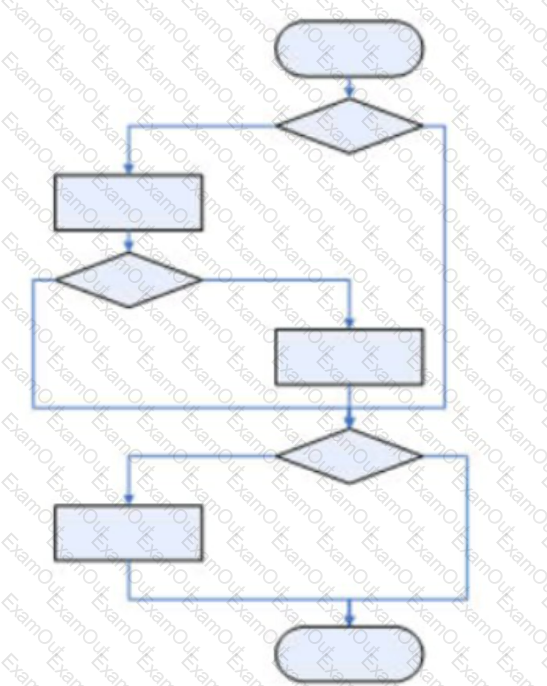Given the following decision: IF X < 5 OR Y > 10 THEN
And the following test inputs: X=6 and Y=12, X=5 and Y=10
Which of the following additional sets of test inputs will ensure that full Multiple Condition coverage is achieved?
Which TWO of the following describe a function of some common web-based testing tools?
A) To generate HTML and XML that is compliant with industry standards such as W3C
B) To provide information on the size of the web pages and on the time necessary to download them
C) To scan and check that no broken or missing hyperlinks are present on a web site
D) To allow applications to be tested by simulating a mobile platform's runtime environment
E) To provide an engine that allows a user to execute a model describing a system's intended run-time behavior
Below is pseudo-code which calculates a customer's cruise credits based on past cruise history:
PROGRAM CALC CRUISE CREDITS (CUST_ID) COUNT_CRUISES, CRUISE_CREDITS, LOYALTY_RATING: INTEGER CRUISE_LENGTH, CRUISE_ACCOM_TYPE: VAR
LOYALTY_RATING = 0
COUNT_CRUISES = 0
CRUISE_LENGTH = 0
CRUISE_ACCOM_TYPE = 0
BEGIN
READ CUSTOMER'S CRUISE HISTORY TO OBTAIN COUNT OF CRUISES
READ CRUISE_HISTORY (CUST_ID)
WHILE COUNT_CRUISES != -1 DO
READ CUSTOMER'S NEXT CRUISE
READ NEXT_CRUISE
IF CRUISE_ACCOM_TYPE = 3 THEN
CRUISE_CREDITS = CRUISE_CREDITS + 5
ELSE
IF CRUISE_ACCOM_TYPE = 2 THEN
CRUISE_CREDITS = CRUISE_CREDITS + 3
ELSE
CRUISE_CREDITS = CRUISE_CREDITS + 2
ENDIF
ENDIF
COUNT_CRUISES = COUNT_CRUISES - 1
ENDWHILE
LOYALTY_RATING = CRUISE_CREDITS / COUNT_CRUISES
WRITE ("CRUISE CREDIT TOTAL IS:")
WRITE (CRUISE_CREDITS)
END PROGRAM CALC CRUISE CREDITS
The code contains data flow anomalies on lines 14 and 27. Which examples of data flow anomalies can be found on these lines?
How many independent paths are shown in the control flow diagram below?

In order to create a shareable testing service from server or network traffic log data, which of the following types of tool would you use?
SELECT ONE OPTION
Your team is now accountable for the support and enhancement of a payroll system that has been in production for many years and modified by many different developers. It has been noticed by management that small functional enhancements take much longer than equivalent changes on more recently developed systems. You have been tasked with implementing improved testing approaches that will help to identify the root cause of this problem.
Which of the following is the best technique to apply in this scenario?
Which of the following is a generic risk factor that should be considered by a Technical Test Analyst during a product risk analysis?
A project to replace your company's sales and merchandising system has begun. The old system is still in production but is poorly documented and expensive to maintain: changing it has often produced a large quantity of defects. The new version will be developed using modern techniques and technology.
Requirements include:
Loading sales data, sent electronically from the stores each evening, into a central database where it is then available for other applications.
Producing sales reports for the merchandisers, whose job is to manage stock levels in stores.
Predictions of future demand for each product, based on a combination of sales history and forecasting parameters.
Requirements 1 and 2 are satisfied by the existing system and will be rewritten with no significant changes. Requirement 3 is new: these forecasting reports will be run overnight, and users will request them by entering simple parameters online during the day.
The sales data are loaded in an overnight batch run. There have been problems at peak periods when this run has taken longer than scheduled, so that dependent jobs could not finish before the start of the working day.
As a Technical Test Analyst, you have been asked to contribute to the project's Master Test Plan. The key stakeholders are:
The Merchandising Manager, who wants parameter entry to be quick and easy.
The Data Centre Manager, who requires the new batch jobs to take less time than the old ones.
No specific performance requirements have been given, either for the batch jobs or for online parameter entry.
Which TWO of the following will BEST meet the objectives of the stakeholders?
Which TWO of the following could be identified using Dynamic Analysis?
A) Objects having too much or too little visibility into parent classes.
B) Repetition of code within a single component or module.
C) System memory not released when it is no longer needed.
D) Pointers in a program that are no longer accurate and must not be used. E. Code that cannot be reached and so will not be executed.
Which option correctly states the sequence of tasks to be undertaken when re-factoring test cases?
SELECT ONE OPTION

